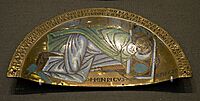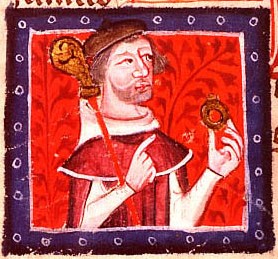Henry of Blois facts for kids
Quick facts for kids Henry of Winchester |
|
|---|---|
| Bishop of Winchester | |

Contemporary plaque showing Henry of Blois, now in the British Museum, c. 1150
|
|
| Appointed | 4 October 1129 |
| Reign ended | 8 August 1171 |
| Predecessor | William Giffard |
| Successor | Richard of Ilchester |
| Orders | |
| Consecration | 17 November 1129 |
| Personal details | |
| Born | c. 1096 Blois, Loir-et-Cher, Centre, France |
| Died | 8 August 1171 (aged around 75) City of Winchester, England |
| Buried | 8 August 1171 Winchester Cathedral |
| Denomination | Catholicism |
| Parents | Stephen Henry, Count of Blois Adela of Normandy |
| Previous post | Abbot of Glastonbury |
Henry of Blois (born around 1096 – died August 8, 1171) was an important figure in English history. He was also known as Henry of Winchester. He served as the Abbot of Glastonbury Abbey starting in 1126. Later, he became the Bishop of Winchester in 1129, a position he held until his death.
Henry was a son of Stephen II, Count of Blois and Adela of Normandy. This made him a younger brother of Stephen, King of England, and a grandson of William the Conqueror. Henry was also a big supporter of the arts. He helped pay for the famous Winchester Bible and the font in Winchester Cathedral. He also started the Hospital of St Cross and built a lot of Wolvesey Castle.
Contents
Early Life and Learning
Henry was one of five sons born to Stephen II, Count of Blois. His mother was Adela of Normandy, who was the daughter of William the Conqueror. This made him the younger brother of King Stephen. We don't know his exact birth date, but he was likely born around 1096 in Blois, France. This was before his father left for the first Crusade.
His father died in 1102 during a Crusade battle. Henry grew up in a family with many castles and lands in France. Henry received his education at Cluny, a famous monastery. There, he learned about intellectual freedom and strict religious rules.
Becoming a Leader: Abbot and Bishop

King Henry I brought Henry of Blois to England. He became the Abbot of Glastonbury Abbey in 1126. On October 4, 1129, he was also made the Bishop of Winchester. He was allowed to keep his role at Glastonbury Abbey, which he loved. He officially became a bishop on November 17, 1129.
Henry wanted to become the Archbishop of Canterbury, which was a very powerful church position. However, he didn't want to give up his duties at Glastonbury. After becoming Bishop of Winchester, he felt that he was less important than the Archbishop of Canterbury. So, he tried to gain more power. He wanted to create a new archdiocese in the west of England, with himself in charge. This plan did not work out.
However, on March 1, 1139, during his brother Stephen's rule, Henry got a special job. He became a papal legate, which meant he represented the Pope. This made him more important than the Archbishop of Canterbury. During a difficult time known as The Anarchy (a civil war), Henry became the most powerful person in the English Church. When his brother the King was busy, Henry of Blois was the wealthiest and most powerful man in England.
King Stephen was crowned in 1135, but the brothers didn't always get along. After a battle in 1141, Henry decided to support Empress Matilda, who was fighting for the throne. But he soon found her to be difficult. Later that year, Henry went back to supporting his brother. With help from Queen Matilda and an army, Henry successfully defended Winchester. This defense was a turning point in the civil war.
As Abbot of Glastonbury, Henry stayed in touch with Peter the Venerable at Cluny. He learned about important debates happening in Europe. For example, he knew about the persecution of Peter Abelard, a famous scholar. He also knew about the translation of the Koran from Arabic to Latin, which Peter the Venerable had ordered.
Building and Architecture
Henry of Blois was an important advisor to his brother King Stephen. He continued to be influential even after Stephen's death. Henry oversaw many building projects. These included villages, canals, abbeys, and smaller churches. He was very proud of his work at Glastonbury Abbey, before a big fire destroyed parts of it in 1184.
Like many important bishops of his time, Henry loved architecture. He added the final parts to Winchester Cathedral and Wolvesey Castle in Winchester. He even built a tunnel under the cathedral so pilgrims could easily see holy objects. He also designed and built additions to many palaces and large houses. This included Farnham Castle in Surrey. He also started building the Hospital of St Cross in Winchester. In London, he built Winchester Palace as a home for the bishops of Winchester.
Henry was responsible for building six castles in 1138. These were at Bishop's Waltham, Downton, Farnham, Merdon, Taunton, and Wolvesey. It was unusual for a bishop to build so many strong castles. Much of Henry's building work was undone in 1155. The new king, Henry II, ordered that many of his castles be torn down.
Books and Literature
Henry loved books and wanted them to be shared widely. He wrote or supported the creation of several books. One was On the Antiquity of the Glastonbury Church by William of Malmesbury, who was a close friend.
He also supported the creation of the Winchester Bible. This is the largest illustrated Bible ever made. It is a huge book, almost three feet tall. This Bible is still on display in Winchester, though it was never fully finished. His creation of the Winchester Psalter, also called the Blois Psalter, is kept in the British Library. It is considered a national treasure in Britain.
Later Years and Passing

Henry's special job as papal legate ended when Pope Innocent II died in 1143. This took away much of his power. He tried to get the job back but was not successful. However, he visited Rome and got some special favors for Glastonbury and the Benedictine religious order.
After his brother King Stephen died and Henry II became king, Henry of Blois retired. He went to Cluny, where he had sent many treasures. He stayed there for at least two years and mourned his teacher, Peter the Venerable, who died in 1156.
In his later years, Henry was among the bishops who had to agree to the Constitutions of Clarendon in 1164. These rules led to a big disagreement with Thomas Becket, the Archbishop of Canterbury. Henry was also chosen to oversee Becket's trial. He secretly supported Becket's family before and after Becket was killed.
Henry died on August 8, 1171. He gave many gifts to Cluny, including a special container for religious items. Henry of Blois is buried in Winchester Cathedral in a simple stone tomb. However, some sources say he was buried at Cluny. Recent studies suggest he was also buried for a time in a small church in Ivinghoe. One idea is that his heart was kept at Cluny, while his body was moved to Winchester in the 1600s. For many years, his tomb was thought to belong to William II, son of William the Conqueror.
William of Malmesbury, who knew Henry well, described him as someone who "blushes when praised," despite his noble background.

